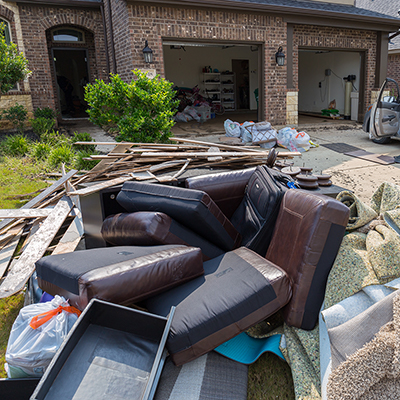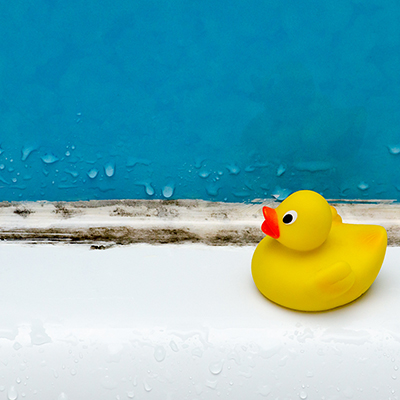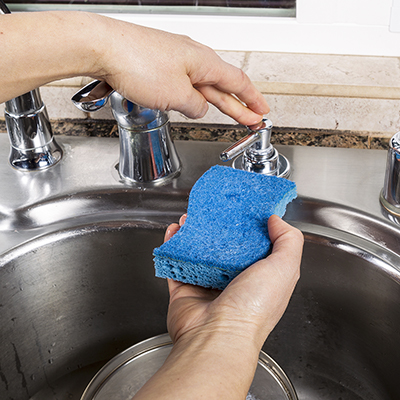How to Get Rid of Mold

Last updated February 5, 2025
A common household problem, mold can spread quickly. Unless you remove it properly, mold can rot wood surfaces, cause unpleasant smells and trigger allergies or serious respiratory problems. It is very important to know how to clean mold from every surface inside and outside of your home. Use this guide to find out how to get rid of mold. Get tips on cleaning solutions and methods that will remove and prevent mold.
Difficulty:
Beginner
Duration:
2-4 hours
Table of Contents
Limit Your Exposure to Mold
Chemical or Natural Mold Cleaners
Mold Removal
How to Get Rid of Mold on a Wall
How to Get Rid of Mold Outside the House
Clean Up After Mold Removal
Limit Your Exposure to Mold

Mold is a type of fungus that grows in areas that have a lot of moisture and warmth. You can see it most often in rooms like baths, kitchens and basements. Mold often has a musty odor and looks like green, black or white dots. Since mold thrives in humid spaces, it is very important not to breathe in mold spores or get them in your eyes while cleaning.
To limit your exposure to mold:
- Wear a mask or an N-95 respirator to avoid inhaling mold.
- Wear rubber gloves. If possible, get gloves that extend to the middle of your forearm.
- Wear goggles that don’t have ventilation holes.
Chemical or Natural Mold Cleaners

Mold removal cleaning products are a good option. You can also make your own cleaning solutions with common household cleaners or natural products.
- Use undiluted white vinegar on hard surfaces in kitchens and baths. Apply it directly to the mold.
- Make a bleach solution to kill mold. Mix one cup of bleach in a gallon of water. Apply it to the surface but don’t rinse it off.
- Mix a 50/50 solution of ammonia and water. Spray on the surface. Wait two to three hours and rinse. Repeat if necessary.
Safety Tip: Never mix ammonia with bleach or other all-purpose cleaners. This will create toxic and dangerous fumes.
Mold Removal

Once you’re properly protected, here’s some basic rules on how to get rid of mold:
- For hard surfaces such as windowsills and tile, scrub mold off with detergent and water.
- For more porous surfaces, like drywall, don’t use a brush. Use a cloth so you don’t damage the surface.
- To remove mold from wood, you may need to sand the wood before cleaning it with detergent. Wear protective equipment and isolate the work area while you're sanding. Use a vacuum with a HEPA filter to clean up any sawdust.
- Always dry any area you clean thoroughly.
- To speed up the job, try a mold cleaner specially formulated with fungicide.
Tip: For very porous surfaces such as ceiling tiles, removing the mold completely may not be possible. Replace the affected material instead.
How to Get Rid of Mold on a Wall

For mold removal on a wall, evaluate the wall surface to figure out how to get rid of mold. If mold covers a large section of a wall or the wall is already damaged, consider replacing it. If the mold is relatively minimal and the wall is in good shape:
- Use a dry brush to scrub off the surface layer of mold. This will make the area easier to treat.
- Take a sponge or cloth and dip it into a commercial or homemade cleaning solution (See Step 2). Wring the sponge out. You don’t want it soaking wet.
- Gently scrub the affected area until the mold is removed.
- Rinse the wall thoroughly with another cloth or sponge and clean water.
- Allow the wall to dry completely. Use a fan or dehumidifier if available.
How to Get Rid of Mold Outside the House

Mold can show up on your soffits, siding, deck and other outside surfaces. This external mold can do significant damage to these surfaces so exterior mold removal is essential for a well-maintained home. If not eliminated quickly, external mold can also work its way into your house.
Here’s how to get rid of mold outside the house:
- Liberally spray a 1-to-10 solution of bleach and water on the affected surface.
- Let sit for 10 to 20 minutes.
- Scrub any tough stains with a stiff bristle brush dipped in the bleach solution.
- Rinse with a garden hose.
Tip: Don’t forget to use rubber gloves and eye protection before you clean mold outside.
Clean Up After Mold Removal

After a mold removal project, it’s important to keep any mold spores from spreading. Carefully clean tools and properly discard of contaminated materials.
- Seal any used rags, disposable gloves or other moldy materials in a garbage bag.
- Clean safety equipment or other tools with hot water and soap or rubbing alcohol.
- Soak brushes in a bleach solution for an hour. Rinse.
- Dry everything completely before storing.
- Always wash the clothes you worked in right away. Use hot water and don't wash any other items with them.
How to Prevent Mold

When it comes to mold, prevention makes all the difference. Mold grows best in warm, humid spaces. Start by locating any areas with moisture issues in and around your home. Repair any leaks and install exhaust fans in the bath, kitchen, basement or laundry room.
Fixing the source of moisture is the only way to prevent the growth and reoccurrence of mold. If there is wood rot with mold growth, the rotten wood should be replaced.
Below are more prevention tips:
Inside:
- Run a dehumidifier to reduce the overall moisture level in your home.
- Run the bathroom fan or open the window when you take a shower to prevent mold from growing.
- In the kitchen, use exhaust fans or open the window when you do the dishes or boil water.
Outside:
- Keep your gutters and downspouts clean.
- Make sure rainwater drains away from your home’s foundation properly.
- Replace any wood or stucco pieces on your home, deck or patio that can’t be completely cleaned of mold.
Mold can grow almost anywhere inside or outside your house. It shows up behind walls, under carpets, on gutters and siding. Cleaning and preventing mold are essential to having a healthier home. Use natural or commercial products to clean and remove mold as soon as you find it. Get the safety equipment and cleaners you need. Use The Home Depot Mobile App to locate products and check inventory. We'll take you to the exact aisle and bay.



























